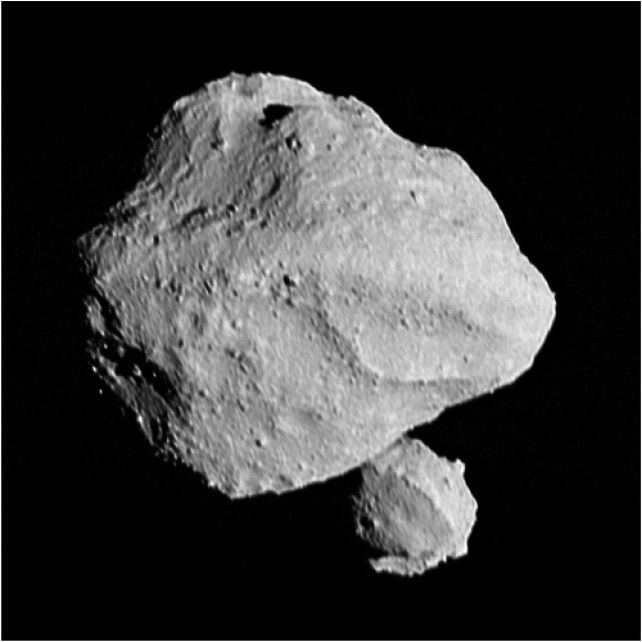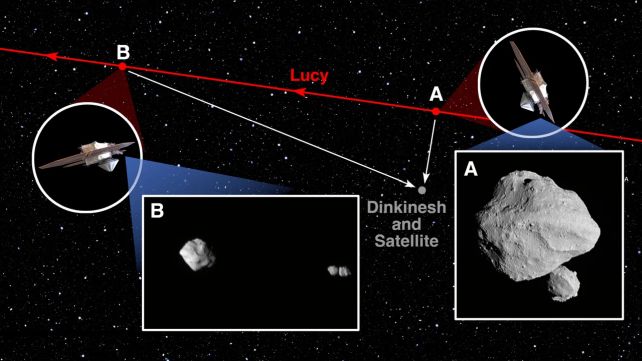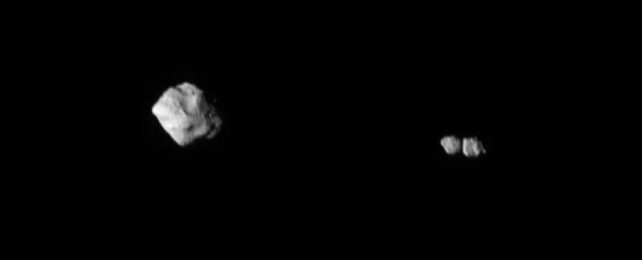It seems like yesterday we were marveling over Dinkinesh (because it practically was) and its secret little moon, and the main belt asteroid has already given us another huge surprise.
The small moonlet orbiting the larger rock, NASA scientists have discovered, is not one moon at all. It's two moons that are glued together like a little snowman, in a type of object called a contact binary.
You may have seen this before, in outer Solar System object Arrokoth – but Dinkinesh's little double moon is the first time we've seen one orbiting an asteroid.
"Contact binaries seem to be fairly common in the Solar System," says astronomer John Spencer of the Southwest Research Institute (SwRI).
"We haven't seen many up-close, and we've never seen one orbiting another asteroid. We'd been puzzling over odd variations in Dinkinesh's brightness that we saw on approach, which gave us a hint that Dinkinesh might have a moon of some sort, but we never suspected anything so bizarre!"

Dinkinesh was the first of 11 asteroid targets scheduled for NASA's asteroid explorer Lucy, which is traveling through the main asteroid belt between Mars and Jupiter as it makes its way out to the Trojan asteroid swarms that share Jupiter's orbit.
The spacecraft completed its Dinkinesh flyby on 1 November, and scientists have since been slowly receiving the trickle of data collected.
In the weeks prior to the flyby, Lucy started picking up periodic changes in the asteroid's brightness, consistent with the light changes you might expect from a binary companion orbiting in and out of view.
And when Lucy got close and snapped some pics from a distance of 430 kilometers (270 miles), the presence of a binary companion was confirmed.
The images collected revealed that the larger asteroid is 790 meters (2,600 feet) at its widest point, while the moonlet is a much smaller 220 meters (720 feet). But, due to the angle of the images, the exact shape of the moon could not be discerned.

But Lucy took more images as it sped away. And, from a distance of 1,630 kilometers, the bi-lobed snowman shape of the moon became clear.
"It is puzzling, to say the least," says planetary scientist Hal Levison of SwRI.
"I would have never expected a system that looks like this. In particular, I don't understand why the two components of the satellite have similar sizes. This is going to be fun for the scientific community to figure out."
Lucy's mission, as we have previously explained, is to study rocks that have remained relatively unchanged since the early days of the Solar System. It's thought that these asteroids are similar to the building blocks from which the planets formed, some 4.6 billion years ago.
Scientists also think that the rocky Solar System planets formed via bottom-up accretion, in which bits of dust and rock in the gas cloud swirling around the Sun accumulated over time, clumping together to form planets.
Finding a gravitationally bound system consisting of multiple objects like Dinkinesh could tell us something about how this process takes place – and how common it is.
The initial measurements suggested that the Dinkinesh system was similar to the Didymos-Dimorphos asteroid binary that NASA smacked a spacecraft into in September of last year, but with some interesting differences.
Now we've found out what one of those differences is, and it's going to give scientists a lot to mull over. And they haven't even finished downlinking the flyby data.
"It's truly marvelous when nature surprises us with a new puzzle," says planetary scientist Tom Statler of NASA. "Great science pushes us to ask questions that we never knew we needed to ask."
Lucy is due to rendezvous with its next main belt asteroid target, Donaldjohnson, in 2025, before continuing its journey out to the Jovian Trojans.
